Samsung HW-Q990C Reviewed at $1,399.00
Product Name: Samsung HW-Q990C
Product Description: 11.1.4 Dolby Atmos Soundbar
-
Design - 9.2/10
9.2/10
-
Movies Performance - 9.5/10
9.5/10
-
Music Performance - 9.2/10
9.2/10
-
Inputs and Features - 8.6/10
8.6/10
-
Price / Quality - 9/10
9/10
Summary
Reviewed at $1,399.00
Pros
- Amazing cinematic sound
- Pass-through capabilities
- Plenty of features
- Good price
Cons
- No HDMI 2.1 ports
- Only 2 HDMI inputs
- No USB playback
- Missing Google Assistant and Chromecast
Cheapest Places to Buy :
*We are a reader-supported website. When you buy through links on our site, we may earn a small affiliate commission at no extra cost to you. Home Media Entertainment does not accept money for reviews.*
Today we turn our focus on soundbars. Some days ago we had the opportunity to check one of Samsung‘s 2023 releases, the Samsung HW-Q800C. Today on the other hand we will go higher in the performance ladder. As a result, in our Samsung HW-Q990C review, we will put Samsung’s flagship for 2023 to the test and determine if it is another stellar release from the Korean manufacturer.
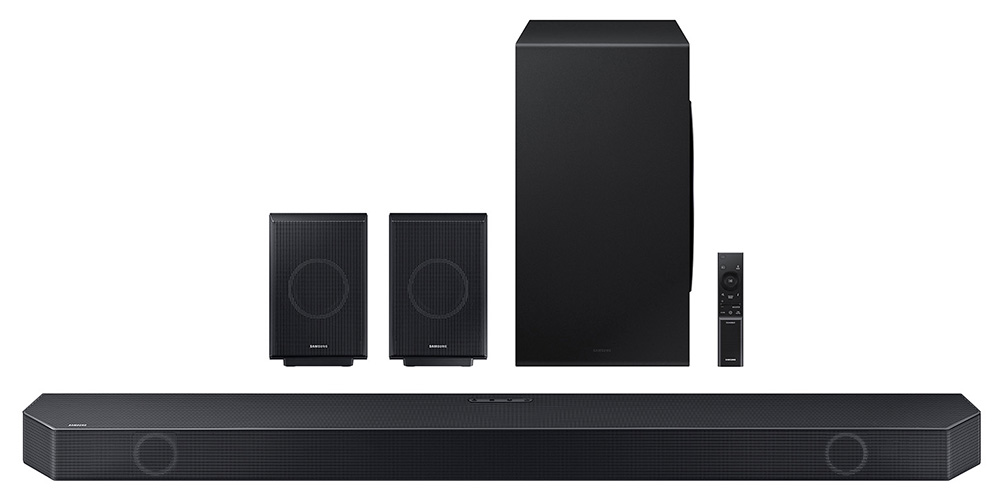
The Samsung HW-Q990C replaces the 2022 HW-Q990B which got really good scores from us last year. But in a market where manufacturers, every single year, try to push the envelope does the new Q990C manage to make waves?
But before we answer the above let’s take a quick look at its specifications. The HW-Q990C is a 11.1.4 channels Dolby Atmos soundbar that includes a subwoofer and surrounds speakers making it a full surround system with a total of 656 watts of power. Except from Dolby Atmos it also supports DTS:X and also comes with plenty of features like WiFi, Bluetooth, High Resolution audio, Amazon Alexa, Airplay 2 built-in and many others like Tap Sound, Q-Symphony and SmartThings app support.
To be honest from the specs alone we do not see any major differences compared to the HW-Q990B, at least hardware wise. Is this just a case of another yearly re-release or there is more to it than meets the eye? Let’s go deeper into our analysis to find out.
Specifications and Features
Design
Dimensions
When we unboxed the soundbar there are two things that we immediately noticed. First was how similar the HW-Q990C is to its predecessor. And second that its color is slightly different than the Q990B.
In terms of size the Q990C measures 48.5″ x 2.7″ x 5.4″ (1232.0 x 69.5 x 138.0 mm) and weights 17.0 lbs (7.7 kg). So the soundbar is indeed the same as the Q900B. This size suits any TV of 55″ and above. But this doesn’t mean that you cannot use this in a smaller sized TV also.
Just keep in mind that if you plan on placing it in front of your TV the soundbar doesn’t have any IR repeaters. This means that it may obstruct the TV’s IR sensor, if the panel is low enough.
Most TVs do have a gap of around 2.5″ but we have encountered some models that are lower than that. So always measure to be on the safe side.
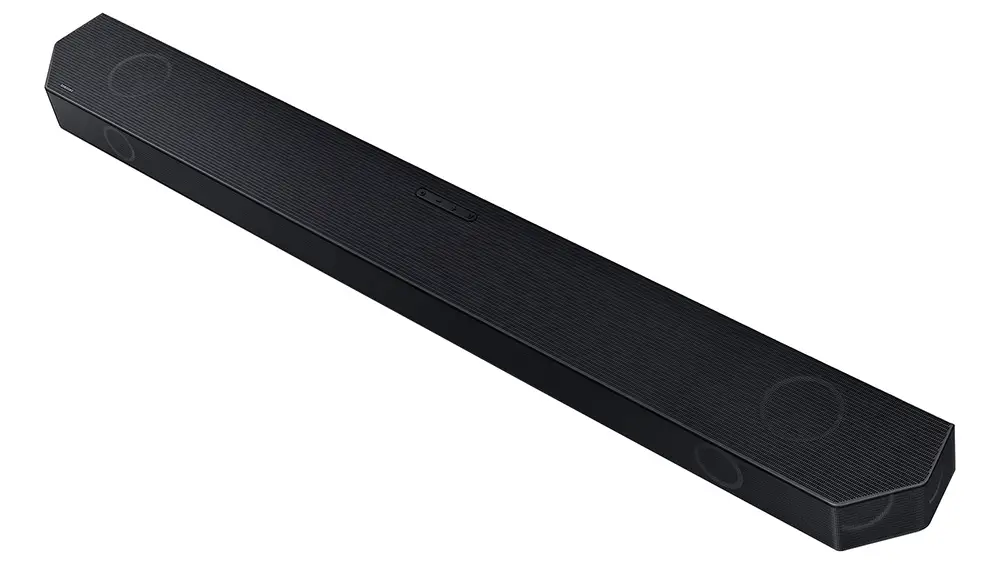
Layout
The whole front, top face and both sides are covered by a metallic perforated grille. This covers the plastic chassis along with all the included woofers. We do like the metal grille more than the fabric cloth that Samsung used some years ago. So this is a somewhat positive design change.
As usual at the top side we find some built-in buttons placed right in the middle while the Samsung logo is placed on the far left. You can almost see the up-firing woofers under the metal grille but otherwise the top side is pretty minimalistic.
At the back we find a few insets that house all the available connection ports. As usual the power port is separated from the rest on the right side. This can be slightly frustrating if you want to group all cables together and keep them hidden from plain sight.
Colors & Quality of Materials
The soundbar comes only in a single color, black. There are no other variants that we know of. Samsung always offers their Q series in just one color. Surprisingly this is not exactly the same color as the one used in the HW-Q990B. The HW-Q990C comes with a lighter shade of black, which we would more accurately describe as dark grey rather than true black.
But this is the only difference. Build quality is the same as before and up to the usual Samsung standards. The soundbar feels sturdy even though it misses the exotic materials of some other flagship units.
Overall a very good design but without trying to impress.
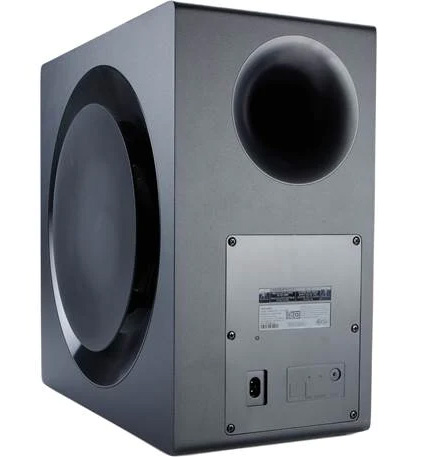
Display Type
One thing we pay a lot of attention with soundbar designs is the display. And the HW-Q990C uses a full functions display, which is the best you can get.
But with its drivers taking most of the space at the front this had to relocate to the far right side. Not a big problem but surely this will bother anyone that like things to look more symmetrical.
The display may not be as big as in some other flagship units like the Klipsch Cinema 1200. But it’s far better than those LED light indicator displays that some brands are using. With a full functions display it’s much easier to read what the soundbar is doing and gives you visual clues of various settings and inputs.
Subwoofer
The main unit is not the only part that hasn’t changed. The included subwoofer is also the same one that came last year with the Q990B.
The sub uses a ported design with a side firing driver that is covered by a plastic plate. We like this look far better than previous subwoofer designs as it looks more modern. Materials used is mainly some short of wood, as most subwoofers use, while at the back a big air port is located at the top with the power connector and a pairing button placed at the bottom of it.
The subwoofer measures 8.7″ x 16.3″ x 16.1″ (220.0 x 413.0 x 410.0 mm) and weights 25.8 lbs (11.7 kg). Surely the side firing design is not the ideal if you want to fit this somewhere between furniture as you will need to make sure you leave enough breathing space in front of the woofer. As always with these soundbars, the subwoofer connects to the main unit with a wireless connection but still needs a power cord to operate.

Surround Speakers
The surrounds, or rear speakers as most manufacturers call them, are also the same as last year. They are covered also in a metallic perforated grille while the rest of the body is made out of plastic. These have three drivers each which is impressive for a rear speaker. This is the reason why these are relatively big for surround speakers. But more on this momentarily.
We measured them 5.1″ x 7.9″ x 5.5″ (129.5 x 201.3 x 140.4 mm) and with a weight of 7.5 lbs (3.4 kg) you have to make sure you have enough space to place them correctly. Because with three channels each they need the necessary space in front of each driver to do their thing. The speakers are wireless but they still have power cables so you cannot call them completely wireless speakers like some JBL soundbars have.
Internal Hardware
Let’s talk a bit more about its internals now. As we mentioned above the HW-Q990C seems to borrow the exact same configuration as its predecessor.
Configuration & Power Distribution
The HW-Q990C is rated as a 11.1.4 channels soundbar with 22 speakers being utilized across 16 different channels. Although there is no change this year the HW-Q990C remains an impressive soundbar even as it is.
Power distribution is 246 watts for the main bar with a (18 W x 4) + (10 W x 2) + (18 W x 2) + (10 W x 1) + (18 W x 6) configuration, 200 watts for the subwoofer and 210 watts for the rear channels with a (35 W x 6) configuration. Total power output is 656 watts.
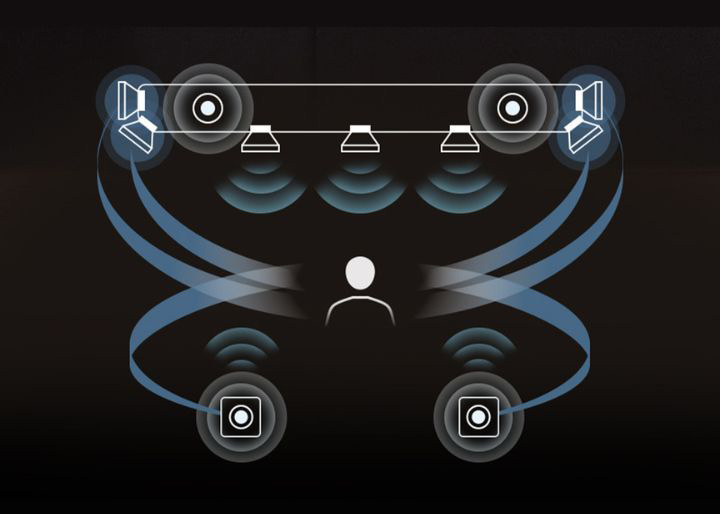
Channels Analysis
For the main unit we have the three main front channels and for these Samsung has used dual oval woofers along with a single tweeter for each channel.
Along with them they have included a single round woofer for the side front, side wide and Atmos channels which is exactly the same configuration as previous Samsung flagships.
Samsung continue to utilize dual side-firing drivers in their top tier units. These are positioned at different angles. One that is at an angle towards the room and one that is looking completely sideways. This way the soundbar is capable at covering the full space at the front and on the sides which in theory will create a more deep and fulfilling performance.
Next we have the up-firing Atmos round woofers which are of the same size as the side firing ones and this is a standard type we see in many Atmos capable units and rely on the ceiling to bounce the sound down above your head.
The surround speakers are also one of a kind as was the case last year. And this has to do with the fact that each of the two cabinets actually hosts three round woofers inside it! One for the direct surround, one for the up-firing Atmos channel and one that is angled outwards in order to close the gap with the front side firing channels and offer a complete 360 degrees immersion bubble.
Last but not least is the subwoofer which includes a side-firing driver for the low frequencies.
Connectivity
Next we will be looking at the available ports that are placed in three special insets at the back of the unit. We would love to have them all grouped together for easier cable management but unfortunately this is not the case.
What we get is a digital optical audio input and three HDMI ports, two inputs and one output. There is also a USB-A port at the bottom which is used for service only while the power connector is separated from the rest and placed on the other side of the unit.
HDMI Notes
Although there is no specific mention of what HDMI ports the HW-Q990C comes with, looking at the HDMI capabilities on the manual reveal that these are actually the older HDMI 2.0 kind. And this is obvious as they cannot pass-through anything more than 4K@60Hz content. Which is really disappointing if you are a gamer and you want to pass-through high frame rate signals.
Also having only two HDMI inputs does limit your options greatly and you cannot connect multiple devices on the soundbar anyway. Your only option is either use a HDMI splitter and have to settle only with 4K@60Hz signals or connect your console or computer to the TV directly.
The third option is to use the TV as a hub and take advantage of the eARC port to drive the sound to the unit itself from the TV but eARC certainly has its own share of problems to begin with. And also keep in mind that your TV needs to support DTS sound if you want this format to be passed through to the soundbar itself.
The HDMI ports except from 4K pass-through support Dolby Vision, HDR10+ and CEC commands.
It’s really disappointing to see a flagship soundbar still stuck with HDMI 2.0 ports. We would expect that Samsung would at least upgrade this part of their new unit. HDMI 2.1 ports are the standard in many high tier Samsung TVs for some time now. And considering this, their soundbars feel like they are stuck in the past.

A Few More Points of Interest
As mentioned above the USB port is only used for service. There is no USB playback available.
Wireless capabilities
Also we shouldn’t forget to mention the unit’s wireless capabilities as it features built-in WiFi along with Bluetooth but only with SBC codec which is the most basic form of Bluetooth support.
Control Options
Next we will be looking at the ways you can control the soundbar. And from everything we saw nothing has changed.
Remote
The One Remote is the same we saw in 2022. It has a bit of a premium look and keeps the same practicality as in the previous years.
The two buttons above the navigation controls are for source selection and Bluetooth pairing. While the other three below the circular navigation controls are for sound mute, sound mode selection and information.
Below these we find the woofer and volume controls while at the bottom three additional circular buttons are used for channels volume control, the second for sound control which includes many sound calibration options like AutoEQ, Spacefit sound, AVA, Voice enhance mode, Night mode, Sync, Surround speaker mode, and Virtual along with specific frequency settings and lastly tone control for setting the treble and bass.

Built-in Controls
The soundbar couldn’t do without some built-in buttons. There are four physical buttons and from left to right we find a multi-function button, volume controls and a microphone control button.
HDMI-CEC
The soundbar supports HDMI-CEC which means that if you connect the unit to the TV with a HDMI cable you can use the TV’s remote to handle some basic controls like volume. This may not give you the complete range of supported functions but it may help in certain situations.
Mobile App
The soundbar may not have a dedicated app but as with most Samsung soundbars it supports the SmartThings app. Surprisingly, with the HQ-Q990C we can do more with the app than with other Samsung soundbars.
Other than the more basic functions like input selection, volume control and change sound modes now you also have a graphic EQ and also individual channels setup. These were available only through the remote and not in the app in some lower tier Samsung soundbar we tried before. Which is a welcome change as now the app feels much more useful than before.
Also the app is required in order to connect the soundbar to your local network. Lastly you get the option to connect to SmartThings Hub if this is something you are interested in. This option was not available before.
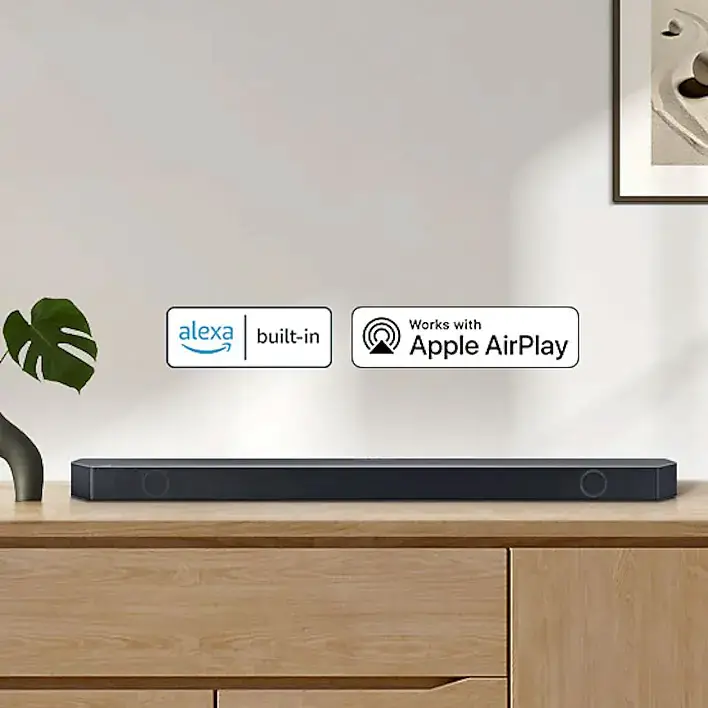
Voice Control
Also due to the inclusion of the built-in WiFi module we get Amazon Alexa in order to control the soundbar without the need of a remote.
You can also use Google Assistant but you will need an external device for that to work.
Extra Features and Services
Now let’s talk about all the extra features we get and we will start with the audio formats supported.
Audio Formats & technologies
The soundbar supports Dolby Digital, Dolby Digital plus, Dolby TrueHD, Dolby Atmos, DTS, DTS:X and LPCM, up to 7.1 channels. These are pretty much everything you should expect and basically the same with many soundbars in the same category.
The HW-Q990C also supports Wireless Dolby Atmos, which means you can connect the soundbar to the TV through WiFi and skip on the cables. Unfortunately this feature only works with specific Samsung TVs.
For music you also get High Resolution Audio decoding so except from the usual, low quality formats like MP3, AAC and WMA you can playback files like FLAC, ALAC and WAV for higher quality.
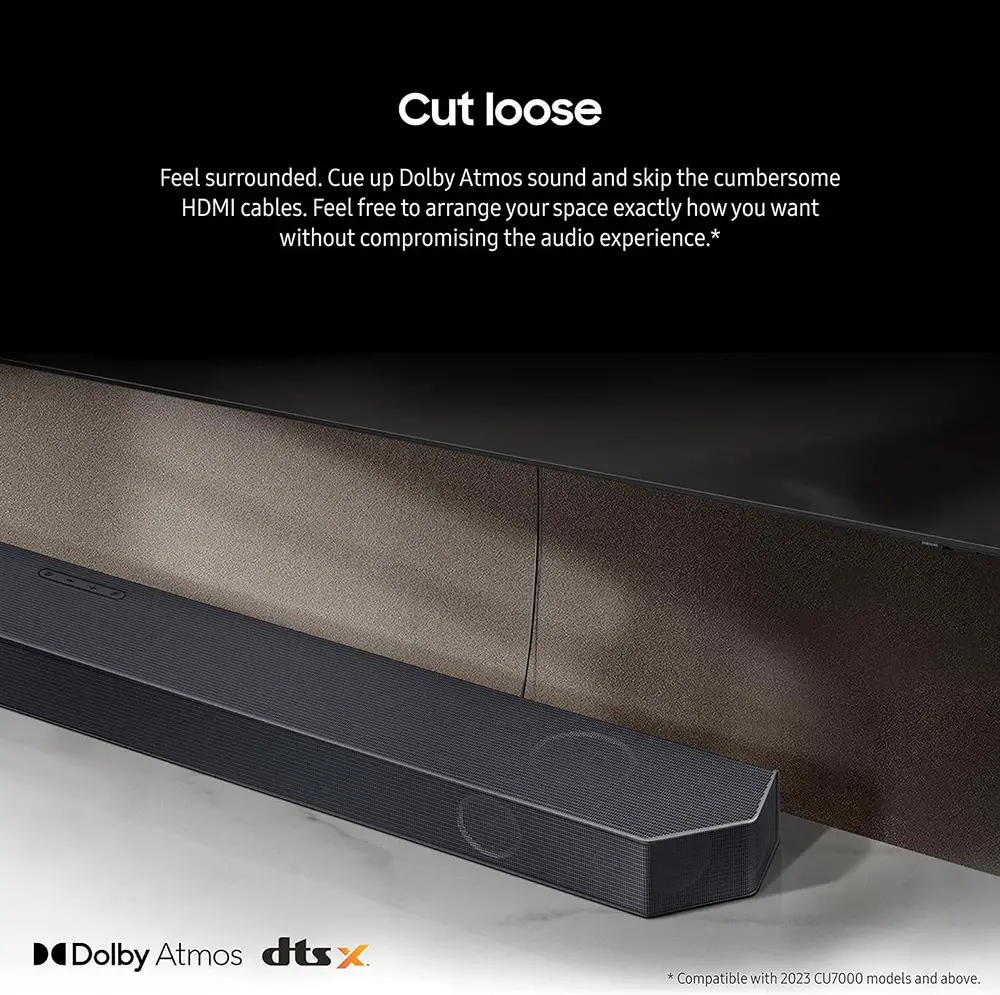
Sound Management
In terms of sound management we get the usual Samsung treatment. You can adjust the bass and treble individually. You can also adjust the woofer (bass) volume through its dedicated button.
But if you want to delve deeper, the Q990C also offers a seven band manual adjustment option.
There is also an individual channels adjustment feature for the Center level, Side level, Wide level, Front Top level, Rear level and Rear top level. The last two are only accessible if you add the optional rear speakers kit.
All the above you can adjust either from the remote or through the SmartThings app.
Sound Modes
There are four dedicated sound modes available. The Standard mode which outputs the original audio mix as it is and Surround Sound that provides a more wide sound field than the Standard mode.
We also get Game Pro mode which provides stereoscopic sound to immerse you in the action while gaming. And lastly Adaptive Sound which analyzes the content audio and provides the optimal sound field accordingly.
One thing we should note here is that with the Standard mode if you feed the soundbar with a 2.0 channels signal you will only get up to 2.1 channels of output. On the other hand for 5.1 and 7.1 channels signals you will get 5.1 and 7.1 channels output respectively. For Dolby Atmos and DTS:X you get 7.1.4 channels output.
Only in Surround, Game Pro or Adaptive sound modes you get the full 11.1.4 channels from the unit. Also, in these modes, when a Dolby Atmos or DTS:X signal is detected then all available channels are enabled.
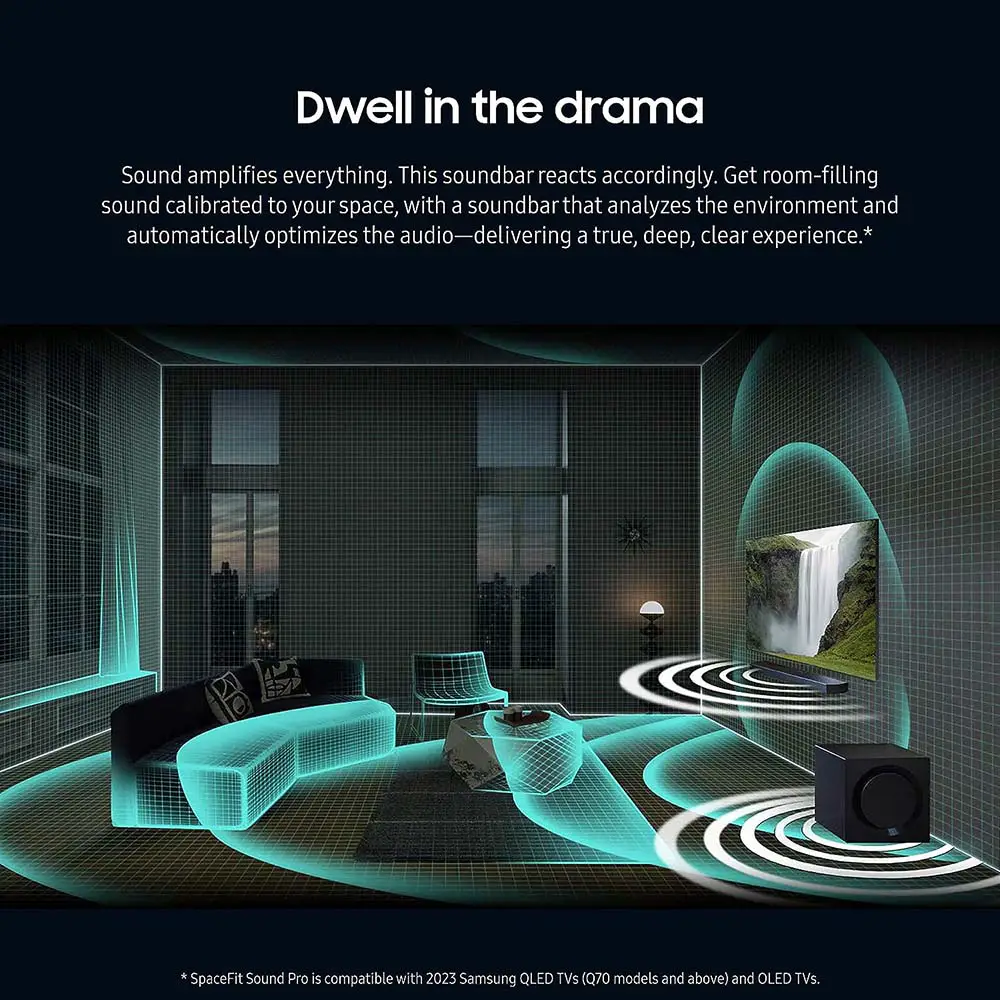
Auto Calibration System
In 2022 Samsung added an auto calibration system which is included in this year’s release also. This is no other than the familiar SpaceFit Sound system. We have seen this feature in some of the higher tier Samsung TVs which uses a special sensor in order to analyze your room and calibrate the audio output accordingly.
Keep in mind that there are different versions of this system that Samsung uses accordingly. The one in the HW-Q990C is called SpaceFit 2.0 or SpaceFit Sound Pro. SpaceFit can be enabled either by the soundbar’s remote, the SmartThings app or if you have a Samsung TV that supports this system, from the TV itself.
This advanced version of SpaceFit takes into consideration the subwoofer’s output also which was not the case previously. This is a really important addition as calibration is far more accurate now than before.
We strongly suggest you run this feature in the beginning as it will greatly improve the audio output. We tested it before and after and the difference was more than obvious.
Streaming
There is also a full set of multi-room and online streaming features including Airplay 2 in case you are more into Apple’s devices, Spotify Connect and also Tidal Connect for some high quality music. Unfortunately Chromecast is missing.
The unit also comes with Bluetooth connectivity. First of all you have the ability to stream audio from any mobile device through a Bluetooth connection. Also if you don’t want to mess with cables you have the ability to connect it to your TV through Bluetooth if your TV also can support such a connection.
Keep in mind that when you connect your TV with the soundbar through Bluetooth you can stream only stereo audio as Bluetooth cannot sustain higher bandwidth that surround audio formats require.
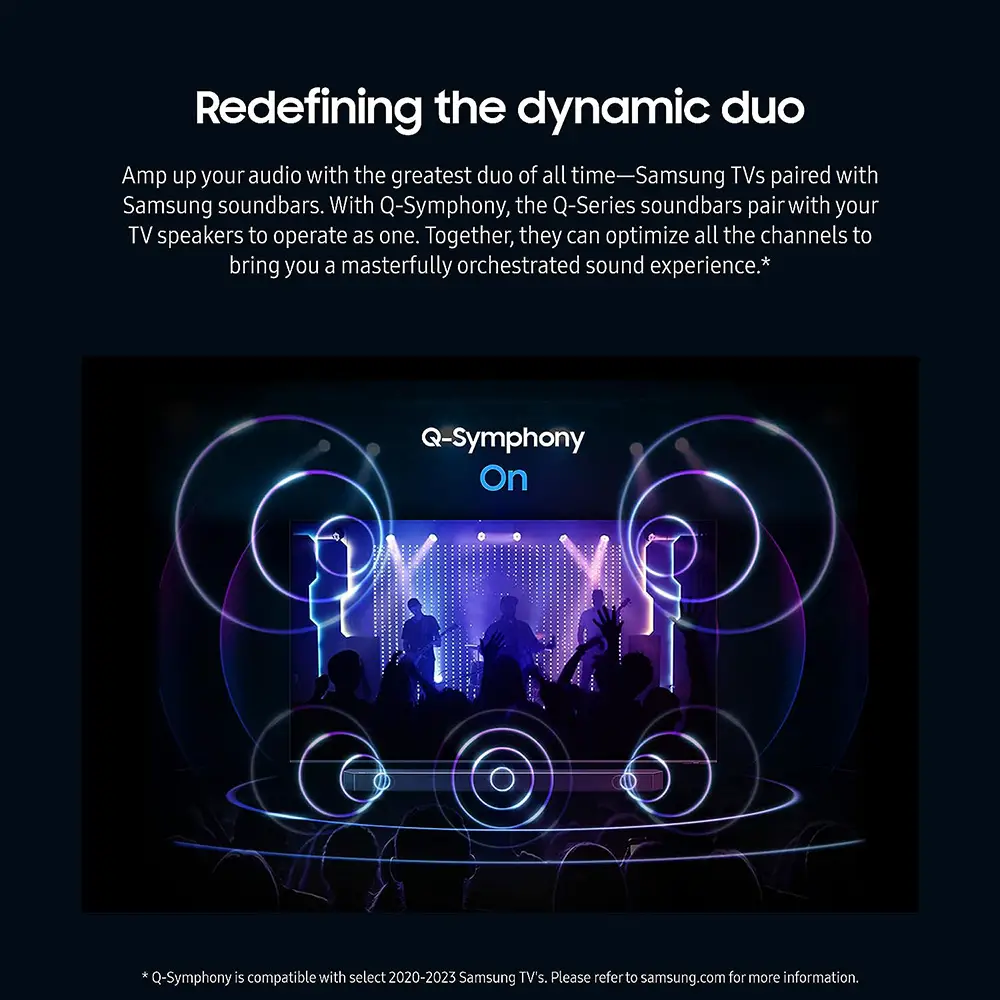
Q-Symphony
We also find Samsung’s Q-Symphony3.0 feature. This feature is also updated this year as now it uses all speakers in both the TV and the soundbar along with the TV’s processing power in order to further analyze and process the audio signal.
This way the TV takes an active part into the sound reproduction in order to up the immersion even further.
Tap Sound
Another fancy feature is Tap Sound and with it you can mirror music from your phone to your soundbar with just a tap. Obviously your mobile device must support this feature also. But with it you save yourself the trouble of going through the connection process each time. Nothing major but a nice little feature to have.
Initial Setup
Chose How to Connect
The HW-Q990C comes with plenty of options to consider when connecting it. This way you can choose the one that suits your needs better.
If you prefer to go the wired route you can either use the HDMI connection either in a pass-through configuration or at the end of the chain with the use of the ARC/eARC functionality. There is also an optical port in case your devices do not have an HDMI port.

But the soundbar also offers you the option to connect it to the TV through a wireless connection. This can be achieved either through Bluetooth or with WiFi. But to be honest we would suggest such a connection only if a wired solution is absolutely out of the question.
Wireless connections are not so stable and you may have problems with such one. And with Bluetooth you can only get stereo audio so you will be limiting the unit’s performance this way.
Further Steps & Calibration
After you connect all parts to the appropriate power outlets then both the subwoofer and main unit should pair automatically. If for some reason they don’t then you can do it the manual way and there are very clear and easy instructions in the manual to do that.
The next obvious step is to calibrate the unit and choose a specific sound mode. After that you are all set.
Movies and TV
Let’s move on to our real world testing now. For this review we tried out Godzilla vs Kong and Terminator: Dark Fate. Both of them in 4K UHD that use very immersive Dolby Atmos mixes.
As for TV viewing we sampled various news broadcasting channels, some TV series and a couple of sports channels.
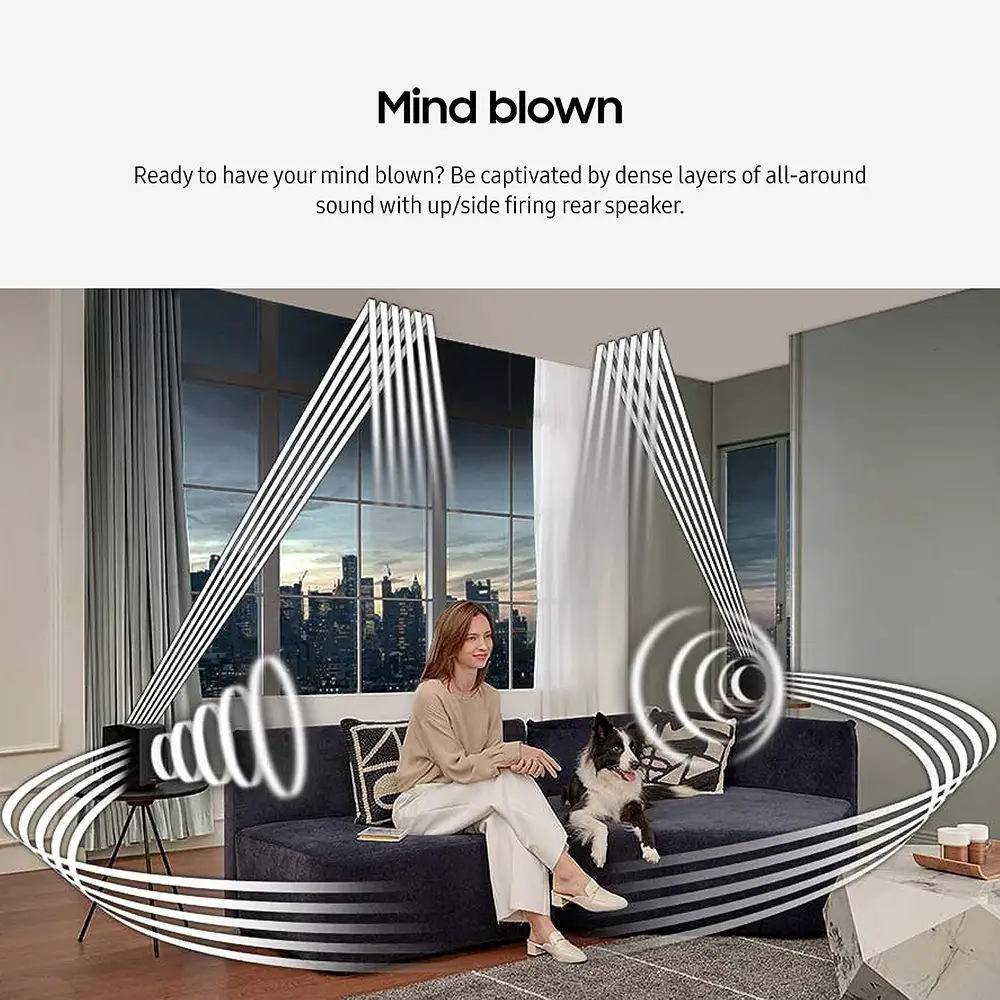
Front Soundstage
One of the first things you immediately notice when you listen to this soundbar is its immense scale. The HW-Q990C knows how to push sound further than the physical boundaries of the unit itself and its multiple drivers configuration certainly helps with that.
The front soundstage was impressive to say the least. You will hear sounds that not only originate from the center where the TV is located but also from multiple angles and heights. The sense of directionality was really distinct and precise.
Especially with Godzilla vs Kong, the soundbar did an excellent job at making you feel the real scale and weight of these monsters. Obviously the subwoofer did its thing here but it was not only the low end that was really prominent here. It was how the entire drivers array worked in harmony in order to give you the illusion of size that you could see on screen.
Dialog
Having a dedicated center channel plays a huge role in delivering crisp and distinct dialog. And the Q990C passed with flying colors here.
TV shows and sports broadcasting were distinct and very clear. So much that we didn’t even need the available Voice Enhance mode.
But even with the movies we tried dialog clarity was top notch. All voices were firmly isolated in the center and we didn’t notice any overlapping with the rest of the channels.
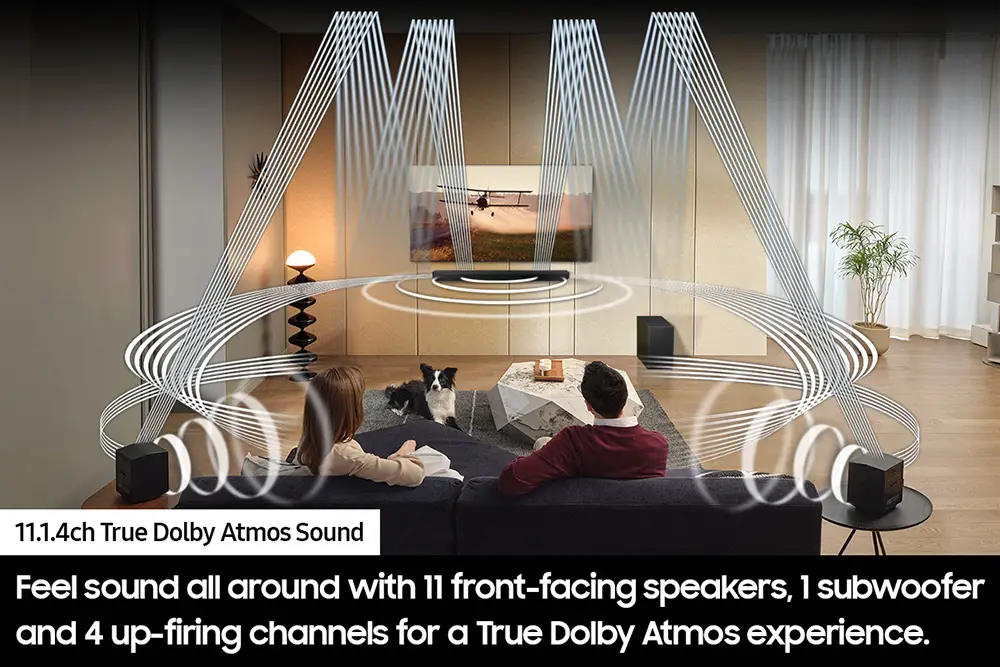
Surround Sound
If you want true immersion you need rear speakers to produce surround sound. And here the HW-Q990C did an excellent job. The rear speakers complemented the action nicely adding depth and activity behind our viewing position. Panning sounds would travel across our viewing area with precision and no sensible delay.
The rear speakers provided much more than just an extra surround layer. With three drivers in each of them we got nice expansion in the entire surround field, including above our heads. As such this soundbar is one of the few ones that can claim complete cover of the entire 360 degrees immersion bubble.
Dolby Atmos
This unit features dedicated up-firing Dolby Atmos. Two front up-firing channels are good, but having four of them is even better.
As a result the HW-Q990C performed as good as any Dolby Atmos enabled soundbar will ever be. Obviously up-firing drivers do not offer the clarity and precision or real ceiling or height channels, but it is definitely the next best thing to have.
And the Samsung soundbar took advantage of them to their maximum potential. You will surely hear sound separation at the overhead layer with sounds emitting both on top of the TV and slightly above our heads and behind. As such you could feel an environment that is more immersive and realistic to the action on screen.
Usually with up-firing speakers sound feels a little lower and a bit less precise and this is the case here also. So don’t expect the Q990C to directly compete with a true Atmos system, but is the next best thing if having speakers on the walls or the ceiling is not an option.
But there are certain limitations to such an implementation. Since all these Atmos soundbars bounce audio on the ceiling and down to you, your room will define the Q990C’s performance. A high ceiling that is not horizontally straight will diminish the Atmos effect to a great extent. A small room with low straight ceiling on the other hand will make Atmos effects more pronounced.
So always keep in mind of the area where you are going to place the soundbar. Because it can make a huge difference.
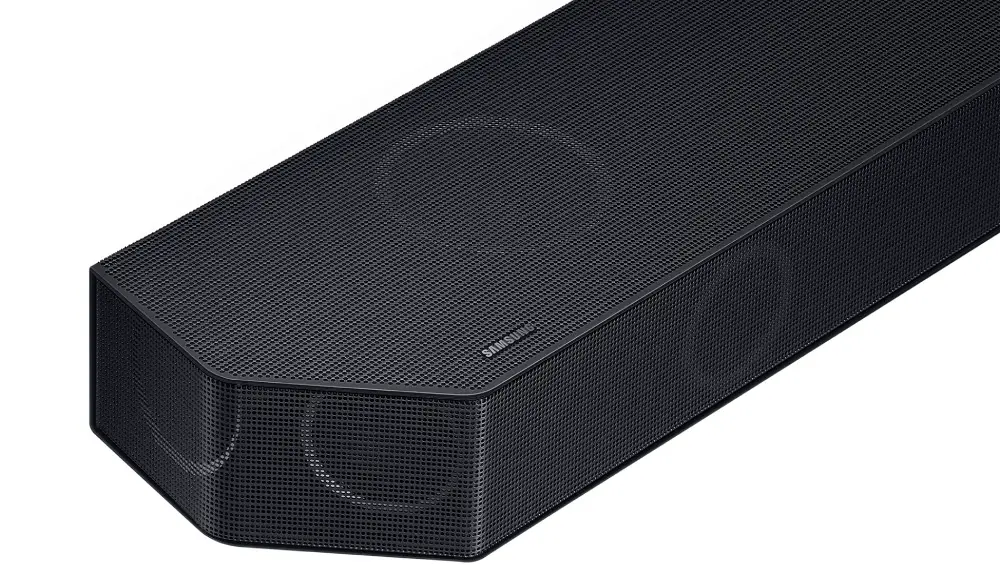
Bass
And let’s not forget the subwoofer that really can offer a very powerful performance. It is not the most delicate of outputs but this sub is meant more for action films and it showed during our testing.
Obviously you are not going to get this chest pounding performance we usually get with top of the line dedicated subs. But it will shake your walls enough to your satisfaction. And if you are more into action films it will please you with its prowess and raw defied output.
Maximum Volume
The soundbar can get pretty loud, no doubt about it. But not without a bit of distortion on the upper levels. This can be obvious to some and not so much to others, depending how sensitive you are to sound in general.
But this is something that we expected. Never forget that this is not a dedicated HiFi system. And all soundbars, some more than others, cannot avoid a certain level of distortion in the upper volume levels. But in general the HW-Q990C performed really close to the top in comparison.
Music
There are many ways to stream music to this soundbar. But for this review we opted to use our Zidoo media player in order to playback some FLAC music files we have at hand.

Fidelity & Overall Quality
The unit performed really close to its predecessor here. With similar hardware this couldn’t be otherwise. Small differences are normal to exist but in general we heard all the same characteristics the HW-Q990B had.
A flagship soundbar should be capable of showcasing good clarity and enough attention to detail. And both of them were present with this one. There was enough linearity, something we notice in many of Samsung’s releases.
The mid range was very easy going while the high end had the necessary energy without being bothering to risk ear fatigue.
As with many soundbars the HW-Q990C had satisfactory sound imaging without managing to go beyond what the average high profile soundbar can do. Panning sounds had nice traveling distance and the switch between the channels was very precise and accurate.
Surprisingly we were expecting a bit more from the subwoofer. Don’t get us wrong, the sub had enough power to keep the low end bit rocking. But with a few demanding performances we felt it lacked a bit in refinement and accurate representation of the low end section.
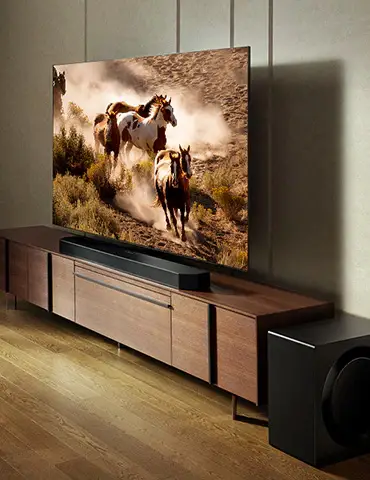
Different Content
We went through various content and we didn’t notice much variation in its performance output. The Q990C proved a very stellar performer across the board.
Some more delicate performances surely lacked the finesse you hear with dedicated HiFi music equipment but you cannot expect to get anything close to that.
The HW-Q990C is your typical soundbar performer and if you are aware of its limitations then you are going to enjoy its musical merits.
Compared to other Soundbars
We couldn’t do this comparison without mentioning the 2022 Samsung HW-Q990B that it replaces. Both soundbars are the same in hardware and have small differences in software. The new unit has an updated Adaptive mode, refined SpaceFit Sound Pro calibration system and gets the new Q-Symphony 3.0 feature. SmartThings Hub is also added to the app with ZigBee and Matter support.
At a slightly lower price than the Samsung we find the Sony HT-A7000. The big weakness of the Sony is that for a $1,299 price tag you get only the main bar. No subwoofer and no rear speakers. If you add these then the performance of the Sony is comparable to the HW-Q990C but its price becomes far greater and far beyond what the Samsung costs. If there is one thing where the HT-A7000 is better is that it comes with HDMI 2.1 ports.
Next we have the Sennheiser AMBEO Plus. Similar to the Sony above the AMEO Plus costs exactly the same as the HW-Q990C but you only get the main bar. You can add a subwoofer but no rear speakers. So in this area the Samsung wins without a doubt. The AMBEO plus does have a few extra features you will not find in the Samsung like MPEG-H and 360 Reality Audio support and has very nice virtual sound reproduction for a single soundbar design.
For last we left the JBL Bar 1000. The JBL is slightly cheaper than the Samsung and has true wireless rear speakers which you can move around to your will. On the other hand we felt that the Samsung had slightly better surround reproduction. Overall we liked both soundbars very much and their differences come down to personal preferences. So we will call them equals.
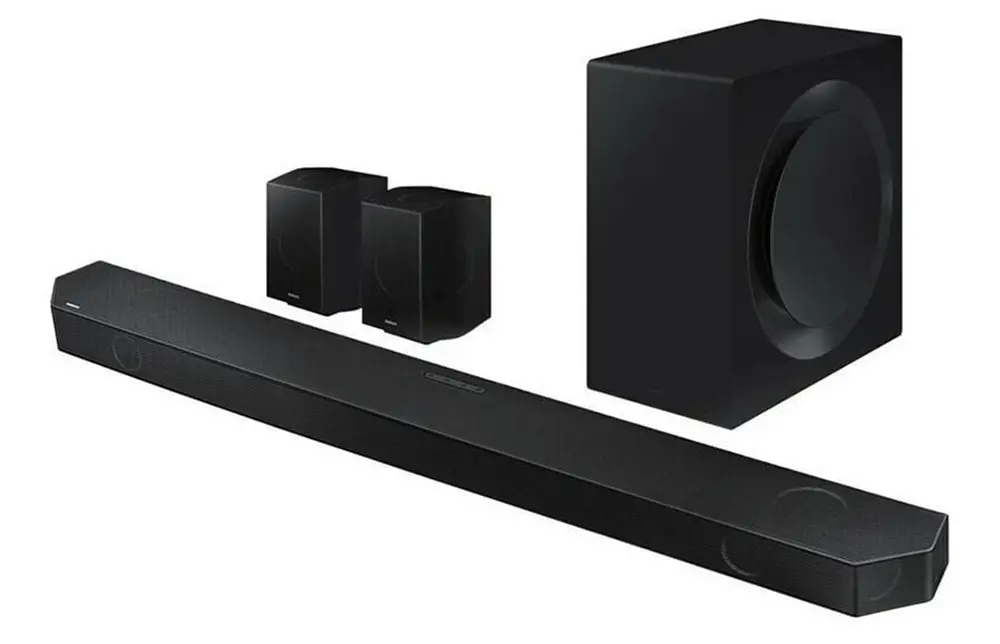
Final Thoughts
It seems that gone are the days when each year new flagships would appear with more channels, more drivers and more power. The Samsung HW-Q990C proved that there is a limit to how much you can constantly add to such a limited space.
The new release is every bit as good as the 2022 model was. But the same design gave the opportunity to Samsung to work a bit on their software. Differences are small but the new HW-Q990C feels a bit more refined and with less bugs than its predecessor. Its cinematic qualities are unquestionable and its musical capabilities proved to be very solid.
But being so similar to last year’s model means that it also carried a few of its limitations. For one more year there are no HDMI 2.1 ports which is disappointing. Two HDMI may not cut it for today’s home theater needs. The unit is missing basic USB playback functionality which is puzzling for a flagship model. And lastly there is no Google Assistant or Chromecast support.
This is the end of our Samsung HW-Q990C review and from all the above we can say that in this price you are not going to find many soundbars that offer a full Dolby Atmos surround experience with all the characteristics and features of this one. Yes, the soundbar has its flaws but from a true value for money perspective this one here is one of the best you can get.
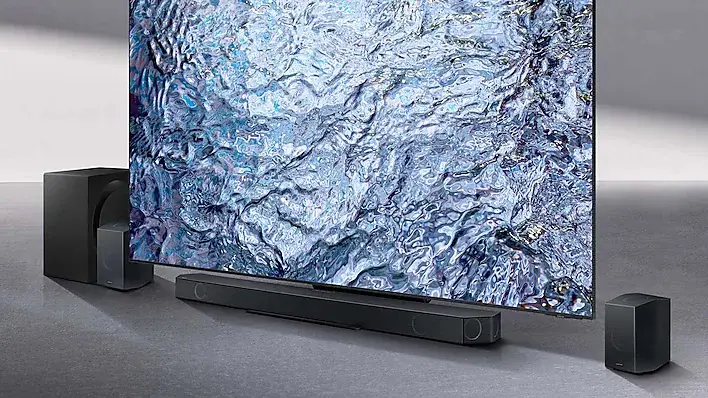
For more reviews you can check our dedicated Full Surround Soundbar reviews list or even look at our Product Reviews Table where you can find the brand and specific product you are looking for.
Cheapest Places to Buy :
*We are a reader-supported website. When you buy through links on our site, we may earn a small affiliate commission at no extra cost to you. Home Media Entertainment does not accept money for reviews.*







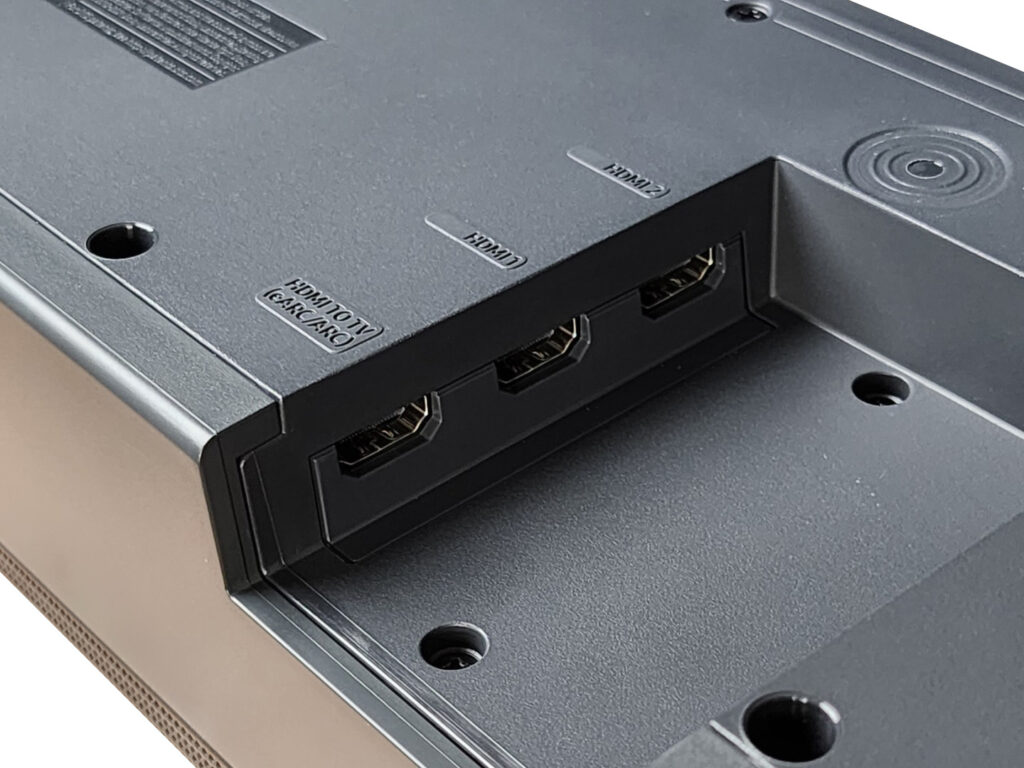
Great OVERALL review! You analyze EVERYTHING on your reviews. This is one of the most detailed article I have read on the Q990C. As you said we have reached a point that brands cannot keep adding more and more each year. I was eyeing the Q990B last year but never pulled the trigger. I was wondering if it is worth it to go for the Q990C instead.
It really depends on what you are looking for. Playing the waiting game will just make you wait forever. The Q990C is not all that different from the Q990B. So if you really want to buy one of them go for the one you can get at the lowest price.
Detailed review as usual.
How do you compare Q990C with JBL 1300X for movies and music.
Hello Ravi. Hmm, difficult question. Both are extremely good with different strengths each. The Samsung can get louder and has more balanced output. The JBL on the other hand may not be as loud as the Samsung but its bass is definitely better and its true wireless rear speakers offer practicality that the Samsung cannot. In terms of Atmos and surround performance they are very similar. So it really depends on what you want the most.
If Samsung Q990C is cheaper than JBL 1300 by 30%, Then which is value for money?
If they have such a big price difference then definitely go for the Samsung, no questions asked.
Hey Stratos,
Thanks for the review. I believe that Samsung missed a huge opportunity with the Q990C. This is basically the same 2022 model so I do not get why they don’t add HDMI 2.1 after so many years. This is their flagship unit and they expect us to pay such an amount with basic 2023 features? This makes no sense to be honest.
Warm regards, Rafael
Hello Rafael. You are not wrong to be honest. But if you pay attention you will notice that many flagship soundbars are still stuck with HDMI 2.0 ports. Only a handful of them offer true HDMI 2.1 support. The way I see things it will be a few good years still until we see many soundbars adopting the latest ports. It is unfortunate but this is the reality we have to accept.